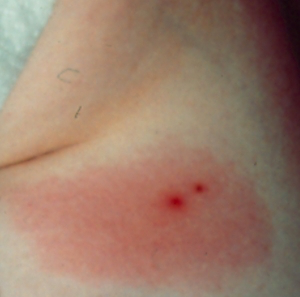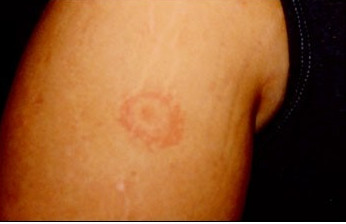
SHARE THIS ARTICLE:
What are Lyme Disease Symptoms & Signs?
Lyme disease symptoms and signs can vary depending on what stage of Lyme disease the patient has. Lyme disease is an infection caused by either Borrelia burgdorferi or Borrelia mayonii 1 bacteria, the latter recently discovered in the Midwest to cause Lyme disease. Both bacteria are transmitted by the Ixodes scapularis tick (deer tick).
What do deer ticks look like? After a bite from an infected tick, acute or early Lyme disease, the infection is limited to the skin, and symptoms generally develop within a few days to a month. Early signs and symptoms may include a rash, a flu like illness with muscle aches and pains, a fever, malaise and fatigue.
Pic 1: Rash with no central clearing  |
Pic 2: Bull’s eye rash
|
According to CDC, a rash does not occur in about 30% of cases,2 but an EM (erythema migrans), an expanding rash with or without a central clearing, often develops at the bite site. Sometimes, the classic bull’s eye rash– a subset of the EM rash—occurs, but only in about 9% of cases3. Lyme disease pictures rash. After Lyme disseminates, which can occur shortly after the bite, a patient may develop late Lyme disease, which can manifest in every system in the body. At this time, a patient may have multiple rashes, and some develop weakness of the facial muscles that looks like Bell’s palsy, other peripheral neuropathies and cardiac4 problems. Choice of Lyme disease treatment with antibiotics depends on length & severity of illness & potential for co-infections. Late Lyme disease symptoms may be present when a patient is diagnosed, since the patient may have had Lyme symptoms which were not previously recognized or were not attributed to Lyme.2 Below is a list of possible Lyme disease symptoms & signs.5 (Printable PDF) Musculoskeletal: joint pain or swelling or stiffness, muscle pain, shin splints, neck or back stiffness, migrating muscle pain or cramps, TMJ, neck creaks & cracks, tender soles. Reproductive: testicular pain/pelvic pain, menstrual irregularity, unexplained milk production (lactation), sexual dysfunction or loss of libido. Cardiac/Pulmonary: chest pain or rib soreness, shortness of breath, heart palpitations, pulse skips, slow pulse, heart block, heart murmur, valve prolapse. Neurological: muscle twitching, headache, tingling, numbness, burning or stabbing sensations, facial paralysis (that looks like Bell’s palsy), dizziness, poor balance, increased motion sickness, light-headedness, wooziness, difficulty walking, tremor, confusion, difficulty thinking/concentrating/ reading, forgetfulness, poor short term memory, disorientation (getting lost, going to wrong place), difficulty with speech, double or blurry vision, eye pain, blindness, increased floaters, increased sensitivity to light or sound or smell, buzzing or ringing in ears, ear pain, decreased hearing or deafness, difficulty swallowing, seizure activity, white matter lesions, low blood pressure. Neuropsychiatric: mood swings, irritability, depression, disturbed sleep (too much, too little, early awakening), personality changes, obsessive – compulsive disorder (OCD), violent outbursts, paranoia, panic/anxiety attacks, hallucinations. Gastrointestinal: nausea or vomiting, loss of appetite, GERD, change in bowel function (constipation, diarrhea), gastritis, abdominal cramping, cystitis, irritable bladder or bladder dysfunction, newly diagnosed irritable bowel syndrome (IBS). Other: fever, sweats, or chills, weight change (loss or gain), fatigue, tiredness, hair loss, swollen glands, sore throat, difficulty swallowing, swelling around the eyes, & swelling in feet. 1 Pritt BS, Respicio-Kingry2 LB, Sloan LM, et al. Borrelia mayonii sp. nov., a member of the Borrelia burgdorferi sensu lato complex, detected in patients and ticks in the upper midwestern United States. 01 November 2016, International Journal of Systematic and Evolutionary Microbiology 66: 4878-4880, doi: 10.1099/ijsem.0.001445 2Bacon RM. Kugeler K, Mead PS. MMWR 2008 57(SS10); 1-9 3 Stonehouse A1, Studdiford JS, Henry CA. An update on the diagnosis and treatment of early Lyme disease: “focusing on the bull’s eye, you may miss the mark”. J Emerg Med. 2010 Nov;39(5):e147-51. Epub 2007 Oct 18. 4 Maloney E. What every primary care clinician should know about the diagnosis of Lyme disease. 2017. https://www.lymediseaseassociation.org/about-lyme/medical-lyme/treatment-guidelines 5 LymeR Primer. https://www.lymediseaseassociation.org/images/NewDirectory/Resources/LDA_Brochures/LymeRPrimer-2013.pdf







